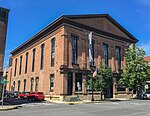Rossman–Prospect Avenue Historic District
Historic districts in Columbia County, New YorkHistoric districts on the National Register of Historic Places in New York (state)Hudson, New YorkNRHP infobox with nocatNational Register of Historic Places in Columbia County, New York ... and 1 more
Use mdy dates from August 2023

The Rossman–Prospect Avenue Historic District is a small residential neighborhood located near the eastern end of the city of Hudson, New York, United States. Its houses were primarily built in the late 19th and early 20th centuries. It is the smaller of the city's two historic districts. The area was developed when the city built an aqueduct through land owned by the Rossman family for a reservoir. It was the first planned residential subdivision in the city outside its large downtown grid plan. In 1985 it was listed on the National Register of Historic Places.
Excerpt from the Wikipedia article Rossman–Prospect Avenue Historic District (License: CC BY-SA 3.0, Authors, Images).Rossman–Prospect Avenue Historic District
Prospect Avenue,
Geographical coordinates (GPS) Address Nearby Places Show on map
Geographical coordinates (GPS)
| Latitude | Longitude |
|---|---|
| N 42.245277777778 ° | E -73.778888888889 ° |
Address
Prospect Avenue 21
12534
New York, United States
Open on Google Maps








